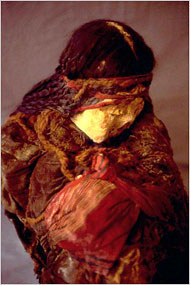Lice Shed Light on Ancient History of Americas

Head lice from 1,000-year-old mummies in Peru are shedding light on the spread of humans and diseases to the Americas.
These new findings suggest, for example, that Columbus did not bring these parasites to the New World — although Vikings might have, scientists added.
"It's kind of quirky that a parasite we love to hate can actually inform us how we traveled around the globe," said researcher David Reed of the Florida Museum of Natural History in Gainesville.
Millions of years
Lice have infested humans for millions of years. Since the parasites have lived with people for so long, scientists are now using lice as a way to shed light on our history. For instance, by estimating the age of the human body louse — which lays its eggs and dwells in clothing — researchers have deduced that modern humans began wearing clothes roughly 40,000 years ago.
"We hope to be able to understand human migration patterns by investigating their parasites, since people have carried these parasites with them as they moved around the globe," Reed said. "By looking at things like tapeworms, pinworms, lice or bedbugs that [early and modern] humans have carried around for at least tens of thousands of years, and in some cases millions of years, we can learn much more about human evolutionary history."
Scientists focused on head lice. There are three known strains — type A is found worldwide, type B in the Americas, Europe and Australia, and type C is rare, known only in Nepal and Ethiopia. Since type B is abundant in North and Central America — accounting for more than half the cases of lice that appear there — researchers had speculated type A originated from Europe and type B from the Americas.
Get the world’s most fascinating discoveries delivered straight to your inbox.
By analyzing these lice, the researchers could uncover whether deadly diseases borne by type A, such as typhus — which decimated Napoleon's grand army — were prevalent in the New World before the arrival of Columbus.
The mummies
The scientists analyzed the DNA of lice found in the long, braided hair of recently excavated, well-preserved bodies naturally mummified by the extremely arid conditions of the south Peruvian coastal desert. Their work revealed these parasites were surprisingly type A, the most common kind, found as far away as the highlands of Papua, New Guinea, and not type B. In other words, this parasite infested the Americas nearly 500 years before Columbus arrived.
"Given its abundance in the Americas on living humans, we thought for sure that (type B) was the one that was here all along and had been established in the New World with the first peoples," he said. "This definitely goes against the grain of conventional thought that all diseases were transmitted from the Old World to the New World at the time of Columbus."
In principle, typhus might actually have originated in the New World, hitching aboard Europeans to devastate millions. "Confirmed cases of epidemic typhus prior to the late 1500s are rare, which has caused speculation that typhus is not an Old World disease," Reed told LiveScience. Similar conjecture has surrounded syphilis.
Although Columbus and subsequent expeditions might not have brought lice to the Americas, the scientists noted that Vikings might have during the Middle Ages. Still, the most likely scenario is that the parasites came with the first people to settle the Americas, Reed noted.
Mystery remains
There is great debate as to when and how the ancestors of the Native Americans first came to the New World, which lice one day might help resolve. It is commonly thought that people traveling across land settled the Americas, but "they would have only had a tiny window of opportunity about 13,500 years ago when there was a gap in the ice sheets," Reed said.
"However, we know that humans had made it deep into South America by 13,000 years, so it's difficult to understand or impossible to believe they could have traveled all that in just a few hundred years," he added. And DNA evidence "suggests people have been in the New World for 30,000 years, with some genes even suggesting 50,000."
Another way people might have settled the Americas includes coming by sea, either hugging the coast in boats from northeast Asia or, perhaps improbably, crossing the ocean from the Pacific Islands. Future research with the lice could shed light on "when and by which route they came to the Americas, as well as the people with them."
The scientists will detail their findings in the Feb. 15 issue of the Journal of Infectious Diseases.
- History's Most Overlooked Mysteries
- Top 10 Intrepid Explorers
- Top 10 Mysterious Diseases



